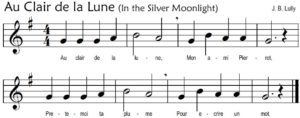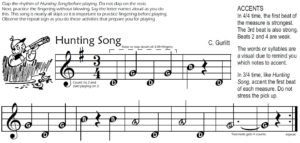Rhythm Lesson 1
RHYTHM is part of learning to read and play music. Rhythm lets you know how long to play a note.
![]() This is a whole note. It gets 4 counts or beats.
This is a whole note. It gets 4 counts or beats.
So it is a long-sounding note.
![]()
This is a half note.
It gets 2 counts or beats.
If the half note has a dot after it, then it is half again as long, so it would get 3 counts.
![]() This is a quarter note. It gets 1 count or beat.
This is a quarter note. It gets 1 count or beat.
![]() This is a quarter rest. It means that there is 1 count or beat of silence. When there is a rest, take a breath.
This is a quarter rest. It means that there is 1 count or beat of silence. When there is a rest, take a breath.
Count the rhythm below as you listen to the sound file. You may slap your leg or rock your upper body forward to feel the beat or pulse. Say each number as you slap, rock, or tap your foot.
Listen to the rhythm again. This time say “du, du, du, du, duuu, duuu” as you hear each note. This is called tonguing. Tongue each note when you play recorder.
There are two large numbers that look like a fraction at the beginning of the line. This is called the time signature or meter. The bottom number tells you that the quarter note gets the beat or pulse. The top number tells you how many beats in each measure (the space between the bar lines). So this rhythm has 4 beats per measure.
See and hear songs that illustrate Rhythm Lesson 1 below.
The song above is in 4/4 time. There are 4 beats in each measure.
The song below is in 3/4 time. There are 3 beats in each measure. This song starts with a pick-up note on beat 3. The first measure is incomplete. Count as you listen to these songs.
Go to Rhythm Lesson 2.


